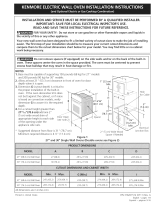
Instrucciones de instalacibn
INSTRUCCIONES DE SEGURIDAD
IMPORTANTES
Para su uridad
• Cerci6rese de que su horno sea instalado
adecuadamente por un instalador calificado
o por un t6cnico de servicio.
• Cerci6rese de que su horno est6 firmemente
instalado en un gabinete que este firmemente
adherido a la estructura de la casa. El peso
sobre la puerta del horno podfia causar que el
horno se voltee resuttando en lesiones. Nunca
permita que nadie se suba, se siente, se pare o
se cuelgue de la puerta del horno.
• Cerci6rese de que los gabinetes y los
revestimientos de la pared alrededor del horno
puedan soportar las temperaturas (hasta 200°F)
generadas por el horno.
ADVERTENCIA:
La energia eldctrica hacia la linea
de suministro del horno debe ser
desconectada mientras se hacen las
conexiones. No hacer esto podfia
resultar en lesiones graves e incluso
provocar la muerte.
Requisitos eldctricos
Este aparato debe ser abastecido con et voltaje
y la frecuencia adecuados, y conectado a un
circuito ramal individual que se encuentre
conectado a tierra apropiadamente. Adem&s,
debe estar protegido por un interruptor de circuito
o fusible que tenga el amperaje requerido por
la tabla de valores. (La tabla de valores est&
ubicada en el marco del horno.)
Recomendamos que el cableado y la conexi6n
etectrica de su horno los realice un electricista
calificado. Despu6s de la instalaci6n, pfda al
electricista que le muestre la ubicacion del
interruptor principal del horno.
Consulte con su compafiia de servicios local
para obtener los c6digos electricos que sean
aplicables en su &rea. No hacer el cableado de
su horno de manera apropiada, respetando los
c6digos vigentes, podfia resultar en condiciones
peligrosas. Si no existen c6digos locales, su
aparato debe usar un cableado y fusibles que
cumplan con los requisitos, del C6digo Electrico
Nacional, ANSINFPA No. 70-Ultima edici6n.
Usted puede obtener una copia de este c6digo
escribiendo a:
National Fire Protection Association
Batterymarch Park
Quincy, MA 02269
A partir del 1ro. de enero de 1996, el C6digo
Electrico Nacional requiere que todas las
construcciones nuevas, pero no existentes, usen
una conexi6n de 4 conductores hacia cualquier
horno el6ctrico. Cuando instale un horno el6ctrico
en una construcci6n nueva, casa m6vil, vehfculo
de recreaci6n o un &rea donde los c6digos
locales prohiban la conexi6n a tierra a trav6s
del conductor neutro, siga las instrucciones en
la Secci6n CONSTRUCCIONES NUEVAS Y
CONEXIONES DE CIRCUITOS RAMALES
DE 4 CONDUCTORES.
Usted debe usar un sistema el6ctrico de tres
alambres, monof&sico, A.C. 208Y/120 voltios o
240/120 voltios, 60 Hertz. Si hace una conexi6n
a alambres de aluminio, debe usar conectores
adecuadamente instatados que esten aprobados
para ser utilizados con cableados de aluminio.
2




















